New Extensions and Applications of the Modified Chumanov Model for Calculating Entry Capacity of Single-Lane Roundabouts
Abstract
1. Introduction
2. Materials and Methods
2.1. Chumanov’s Original Model in Russian Roundabout Guidelines
2.2. The Proposed Extension for the Modified Chumanov Capacity Model
2.3. The Capacity of the Ring Lane
2.4. Vehicle Speed in the Circulating Flow
2.5. Vehicle Distance in the Circulating Flow
2.6. The Complete Entry Capacity Formulation for the MC Model
3. Results and Discussion
3.1. A First Level of Validation: The Comparison with Some Models of Practical Use for the Entry Capacity
3.2. A Second Level of Validation: The Goodness of the Fitting Compared to Some Experimental Situations
- Dataset A: About 300 pairs of circulating flow values—simulated entry capacities for a single-lane roundabout with a small diameter ( = 75′ = 23 m; = 5 m; = 3.5 m) in [63]
- Dataset B: About 260 pairs of circulating flow values—monitored entry capacity for a single lane roundabout with a medium diameter ( = 105′ = 32 m; = 14′ = 4.25 m; = 12′ = 3.65 m) at New York Glens Falls-US 9/ Warren Street in [64]
- Dataset C: About 280 pairs of circulating flow values—monitored entry capacity for two single-lane roundabouts with a medium-large diameter ( = 140–148′ = 44 m; = 23, = 7 m; = 13–15′ = 4.5 m) at 116th–106th Street/Spring Mill Road Carmel in [64]
- Dataset D: Approximately 740 pairs of circulating flow values—monitored entry capacities for single-lane roundabouts of medium-large diameter in [65] assuming a standard geometry ( = 45 m; = 7 m; = 3.5 m)
4. Conclusions
Author Contributions
Funding
Acknowledgments
Conflicts of Interest
References
- Highway Capacity Manual, 5th ed.; TRB: Washington, DC, USA, 2010.
- Highway Capacity Manual, 6th ed.; TRB: Washington, DC, USA, 2016.
- Kimber, R.M.; Hollis, E.M. Traffic Queues and Delays at Road Junctions; Transport and Road Research Laboratory Report No. LR909; TRRL: Crowthorne, UK, 1979. [Google Scholar]
- Mauro, R.; Pompigna, A. State of the art and computational aspects of time-dependent waiting models for non-signalised intersections. J. Traffic Transp. Eng. 2020. [Google Scholar] [CrossRef]
- Yap, Y.H.; Gibson, H.M.; Waterson, B.J. An international review of roundabout capacity modelling. Transp. Rev. 2013, 33, 593–616. [Google Scholar] [CrossRef]
- Mauro, R.; Cattani, M. Functional and economic evaluations for choosing road intersection layout. Promet. Traffic 2012, 24, 441–448. [Google Scholar] [CrossRef]
- Vasconcelos, L.; Seco, Á.; Silva, A.B.; Abreu, T.; Silva, J.P. A comparison of roundabout capacity models. In Proceedings of the IASTED International Conference on Modelling and Simulation, Banff, AB, Canada, 3–5 July 2012; pp. 165–170. [Google Scholar]
- Macioszek, E. Roundabout entry capacity calculation-a case study based on roundabouts in Tokyo, Japan, and Tokyo surroundings. Sustainability 2020, 12, 1533. [Google Scholar] [CrossRef]
- Mauro, R. Calculation of Roundabouts: Capacity, Waiting Phenomena and Reliability; Springer Science & Business Media: Berlin/Heidelberg, Germany, 2010. [Google Scholar]
- Kimber, R.M. The Traffic Capacity of Roundabouts; TRRL Report LR942; Transport and Road Research Laboratory: Crowthorne, UK, 1980. [Google Scholar]
- Service d’Etudes Techniques des Routes et Autoroutes (SETRA). Capacité des Carrefour Giratoires Interurbains: Prémiers Résultats; Note d’information n. 44; SETRA: Bagneux, France, 1987. [Google Scholar]
- Centre d’études sur les réseaux, les transports, l’urbanisme et les constructions publiques (CERTU). Conception des Carrefours à Sens Giratoire Implantés en Milieu Urbain; Ministère de l’Equipement, du Logement, de l’Aménagement du Territoire et des Transports; Centre d’Études des Transports Urbains (CETUR): Lyon, France, 1998. [Google Scholar]
- Bovy, H.; Dietrich, K.; Harman, A. Guide Suisse des Giratoires; Switzerland Guide to Roundabouts: Lausanne, Switzerland, 1991. [Google Scholar]
- Stuwe, B. Capacity and safety of roundabouts-German results. In Intersections without Traffic Signals II; Brilow, W., Ed.; Springer: Berlin/Heidelberg, Germany, 1991. [Google Scholar]
- Polus, A.; Shmueli, S. Analysis and Evaluation of the Capacity of Roundabouts. Transp. Res. Rec. 1997, 1572, 99–104. [Google Scholar] [CrossRef]
- Aakre, A. Norwegian methods for calculation of capacity and level of service at intersections. In NORDKAP-Nordic Capacity Cooperation; University of Lund: Sverige, Sweden, 1997. [Google Scholar]
- Brilon, W.; Stuwe, B.; Bondzio, R. Kleine Kreisverkehre-Empfehlungen zum Einsatz und zur Gestaltung; Ministerium Stadtentwicklung und Verkehr des Landes NRW: Duisburg, Germany, 1993. [Google Scholar]
- Tanner, J.C. The capacity of an uncontrolled intersection. Biometrika 1967, 54, 657–658. [Google Scholar] [CrossRef]
- Siegloch, W. Die Leistungsermittlung an Knotenpunkten ohne Lichtsignalsteuerung; Capacity calculations at unsignalized intersections, in Strassenbau und Strassenverkehrstechnik 1541973. Road Constr. Traffic Eng. 1973, 154, 173. [Google Scholar]
- Hagring, O. A further generalization of Tanner’s formula. Transp. Res. Part B Methodol. 1998, 32, 423–429. [Google Scholar] [CrossRef]
- Cowan, R.C. Useful headway models. Transp. Res. 1975, 9, 371–375. [Google Scholar] [CrossRef]
- Hagring, O. Calibration of headway distributions. In Proceedings of the 13th Mini-Euro Conference Handling Uncertainty in the Analysis of Traffic and Transportation Systems and the 9th Meeting of the Euro Working group on Transportation, Intermodality, Sustainability and ITS, Bari, Italy, 10–13 June 2002; pp. 323–328. [Google Scholar]
- Vasconcelos, L.; Silva, A.B.; Seco, A. A sensitivity analysis of Cowan’s M3 capacity model applied to roundabouts. In Proceedings of the IASTED International Conference on Modelling, Identification and Control, Innsbruck, Austria, 14–16 February 2011; pp. 384–390. [Google Scholar]
- Vasconcelos, L.; Silva, A.B.; Seco, A.; Silva, J. Estimating the parameters of Cowan’s M3 headway distribution for roundabout capacity analyses. Balt. J. Road Bridge Eng. 2012, 7, 261–268. [Google Scholar] [CrossRef]
- Guo, R.; Liu, L.; Wang, W. Review of roundabout capacity based on gap acceptance. J. Adv. Transp. 2019, 2019. [Google Scholar] [CrossRef]
- Akçelik, R.; Troutbeck, R. Implementation of the Australian roundabout analysis method in SIDRA. In Highway Capacity and Level of Service-Proceedings of the International Symposium on Highway Capacity; Brannolte, U., Ed.; AA Balkema: Rotterdam, The Netherlands, 1991. [Google Scholar]
- Van Arem, B. Background of the Program Roundabout Explorer; Instituut voor Ruimtelijke Organisatie TNO: Delft, The Netherlands, 1992. [Google Scholar]
- Brilon, W.; Stuwe, B.; Drews, O. Sicherheit und Leistungsfähigkeit von Kreisverkehrsplätzen; Institute for Traffic Engineering, Ruhr Universität: Bochum, Deutschland, 1993. [Google Scholar]
- Kapacitet og serviceniveau: Baggrund og documentation. Capacity and Level of Service: Background and Documentation; Trafikteknik, Vejregelrådet: København, Danmark, 1999. [Google Scholar]
- Akçelik, R. A review of gap-acceptance capacity models. In Proceedings of the 29th Conference of Australian Institutes of Transport Research (CAITR 2007), University of South Australia, Adelaide, Australia, 5 December 2007; pp. 5–7. [Google Scholar]
- Hagring, O. Capcal 3.2-Model Description of Intersections without Signal Control; Trivector: Lund, Sweden, 2004. [Google Scholar]
- Tracz, M.; Chodur, J. Metody Obliczania Przepustowości Rond—Instrukcja Obliczania; GDDKiA: Warszawa, Poland, 2004. [Google Scholar]
- Luttinen, T. Capacity and Level of Service at Finnish Unsignalized Intersections; Finnish Road Administration: Helsinki, Finland, 2004. [Google Scholar]
- Fortuijn, L.G.H. Turbo roundabouts. Estimation of capacity. Transp. Res. Rec. 2009, 2130, 83–92. [Google Scholar] [CrossRef]
- Mauro, R.; Branco, F. Comparative analysis of compact multilane roundabouts and turbo-roundabouts. J. Transp. Eng. 2010, 136, 316–322. [Google Scholar] [CrossRef]
- Tollazzi, T.; Mauro, R.; Guerrieri, M.; Renčelj, M. Comparative analysis of four new alternative types of roundabouts: “Turbo”, “flower”, “target” and “four-flyover” roundabout. Periodica Polytech. Civ. Eng. 2016, 60, 51–60. [Google Scholar] [CrossRef]
- Macioszek, E. Models of Critical Gaps and Follow-up Headways for Turbo Roundabouts. In Roundabouts as Safe and Modern Solutions in Transport Networks and Systems; Macioszek, E., Akçelik, R., Sierpiński, G., Eds.; TSTP 2018; Lecture Notes in Networks and Systems; Springer: Cham, Switzerland, 2019; Volume 52. [Google Scholar]
- Vasconcelos, A.L.P.; Silva, A.B.; Seco, Á.J.M. Capacity of normal and turbo roundabouts: Comparative analysis. Proc. Inst. Civ. Eng. Trans. 2014, 167, 88–99. [Google Scholar] [CrossRef]
- Deluka Tibljaš, A.; Giuffrè, T.; Surdonja, S.; Trubia, S. Introduction of Autonomous Vehicles: Roundabouts design and safety performance evaluation. Sustainability 2018, 10, 1060. [Google Scholar] [CrossRef]
- Paramics Microsimulation. S-Paramics (Parallel Microscopic Traffic Simulator); SIAS Limited: Edinburgh, UK, 2019.
- TSS-Transport Simulation Systems. Aimsun (Advanced Interactive Microscopic Simulator for Urban and Non-Urban Networks); Transport Simulation Systems: Barcelona, Spain, 2019. [Google Scholar]
- PTV Group. Vissim (Verkehr in Städten-SIMulationsmodell); PTV: Karlsruhe, Germany, 2019. [Google Scholar]
- Behrisch, M.; Bieker, L.; Erdmann, J.; Krajzewicz, D. SUMO–Simulation of Urban MObilit; Aerospace Center; Institute of Transportation Systems: Berlin, German, 2019. [Google Scholar]
- Bakhsh, A. Traffic Simulation Modeling for Major Intersection. Sakarya Üniversitesi Fen Bilimleri Enstitüsü Dergisi 2020, 24, 37–44. [Google Scholar] [CrossRef]
- Tian, R.; Li, S.; Li, N.; Kolmanovsky, I.; Girard, A.; Yildiz, Y. Adaptive game-theoretic decision making for autonomous vehicle control at roundabouts. In Proceedings of the 2018 IEEE Conference on Decision and Control (CDC), Miami Beach, FL, USA, 17–19 December 2018; IEEE: Piscataway, NJ, USA, 2018; pp. 321–326. [Google Scholar]
- Banjanovic-Mehmedovic, L.; Halilovic, E.; Bosankic, I.; Kantardzic, M.; Kasapovic, S. Autonomous vehicle-to-vehicle (v2v) decision making in roundabout using game theory. Int. J. Adv. Comput. Sci. Appl. 2016, 7, 292–298. [Google Scholar] [CrossRef]
- Doniec, A.; Mandiau, R.; Piechowiak, S.; Espié, S. A behavioral multi-agent model for road traffic simulation. Eng. Appl. Artif. Intell. 2008, 21, 1443–1454. [Google Scholar] [CrossRef]
- Wang, R.; Zhang, W.; Miao, Q. Effects of driver behavior on traffic flow at three-lane roundabouts. Int. J. Intell. Control Syst. 2005, 10, 123–130. [Google Scholar]
- Małecki, K.; Wątróbski, J. Cellular automaton to study the impact of changes in traffic rules in a roundabout: A preliminary approach. Appl. Sci. 2017, 7, 742. [Google Scholar] [CrossRef]
- Małecki, K. The Use of Heterogeneous Cellular Automata to Study the Capacity of the Roundabout. In Artificial Intelligence and Soft Computing. ICAISC 2017; Rutkowski, L., Korytkowski, M., Scherer, R., Tadeusiewicz, R., Zadeh, L., Zurada, J., Eds.; Lecture Notes in Computer Science; Springer: Cham, Switzerland, 2017; Volume 10246, pp. 308–317. [Google Scholar]
- Gritschneder, F.; Hatzelmann, P.; Thom, M.; Kunz, F.; Dietmayer, K. Adaptive learning based on guided exploration for decision making at roundabouts. In Proceedings of the 2016 IEEE Intelligent Vehicles Symposium, Gotenburg, Sweden, 19–22 June 2016; Volume 7535422, pp. 433–440. [Google Scholar]
- Zhao, M.; Kathner, D.; Jipp, M.; Soffker, D.; Lemmer, K. Modeling driver behavior at roundabouts: Results from a field study. In Proceedings of the 2017 IEEE Intelligent Vehicles Symposium, Redondo Beach, CA, USA, 11–14 June 2017; Volume 7995831, pp. 908–913. [Google Scholar]
- Capasso, A.P.; Bacchiani, G.; Molinari, D. Intelligent roundabout insertion using deep reinforcement learning. In Proceedings of the 12th International Conference on Agents and Artificial Intelligence, ICAART 2020, Valletta, Malta, 22–24 February 2020; Volume 2, pp. 378–385. [Google Scholar]
- Mauro, R.; Cattani, M. Model to evaluate potential accident rate at roundabouts. J. Transp. Eng. 2004, 130, 602–609. [Google Scholar] [CrossRef]
- Metodicheskiye rekomendatsii po razrabotke i realizatsii meropriyatiy po organizatsii dorozhnogo dvizheniya. Povysheniye effektivnosti ispol’zovaniya kol’tsevykh razvyazok. Guidelines for the Development and Implementation of Measures for the Organization of Traffic. Improving the Use of Roundabouts; Ministerstvo transporta Rossiyskoy Federatsii (MinTrans): Moskva, Russia, 2017.
- Chumakov, D.Y. Proyektirovaniye elementov malykh kol’tsevykh peresecheniy v naselennykh punktakh: Dis. kand. tekhn. nauk: 05.23.11. In Design of Elements of Small Circular Intersections in Urban Settlements; Dis. Cand. tech. Sciences: Volgograd, Russia, 2007. [Google Scholar]
- Ben-Edigbe, J.; Pakshir, A.H.; Ibijola, S.O. Extent of Entry Capacity Loss at Roundabouts Caused by Rainy Conditions. Adv. Civ. Eng. 2018, 2018, 4192323. [Google Scholar] [CrossRef]
- Fambro, D.B.; Fitzpatrick, K.; Koppa, R.J. NCHRP Report 400: Determination of Stopping Sight Distances. TRB; National Research Council: Washington, DC, USA, 1997.
- Norme funzionali e geometriche per la costruzione delle strade. Geometric and Functional Standards for Road Construction; DM 5.11. 2001. Suppl. Ord. GU 3; Ministero delle Infrastrutture e dei Trasporti: Rome, Italy, 2002.
- Vaiana, R.; Gallelli, V.; Iuele, T. Sensitivity Analysis in Traffic Microscopic Simulation Model for Roundabouts. Balt. J. Road Bridge Eng. 2013, 8, 174–183. [Google Scholar] [CrossRef]
- Lamm, R.; Choueiri, E.M.; Mailaender, T. Side friction demand versus side friction assumed for curve design on two-lane rural highways. Transp. Res. Rec. 1991, 1303, 11–21. [Google Scholar]
- Lamm, R.; Psarianos, B.; Mailaender, T. Highway Design and Traffic Safety Engineering Handbook; McGraw-Hill: New York, NY, USA, 1999. [Google Scholar]
- Lochrane, T.W.; Kronprasert, N.; Dailey, D.J. Traffic Capacity Models for Mini-roundabouts in the United States: Calibration of Driver Performance in Simulation 2. In Proceedings of the Transportation Research Board (TRB) Annual Meeting, Washington, DC, USA, 13–17 January 2013. [Google Scholar]
- Johnson, M.T.; Lin, T.L. Impact of Geometric Factors on the Capacity of Single-Lane Roundabouts. Transp. Res. Rec. 2018, 2672, 10–19. [Google Scholar] [CrossRef]
- Rodegerdts, L.A.; Malinge, A.; Marnell, P.S.; Beaird, S.G.; Kittelson, M.J.; Mereszczak, Y.S. Accelerating Roundabouts in the United States: Volume II of VII-Assessment of Roundabout Capacity Models for the Highway Capacity Manual; Report No. FHWA-SA-15-070; Kittelson & Associates Inc. for FHWA HAS: Washington, DC, USA, 2015.
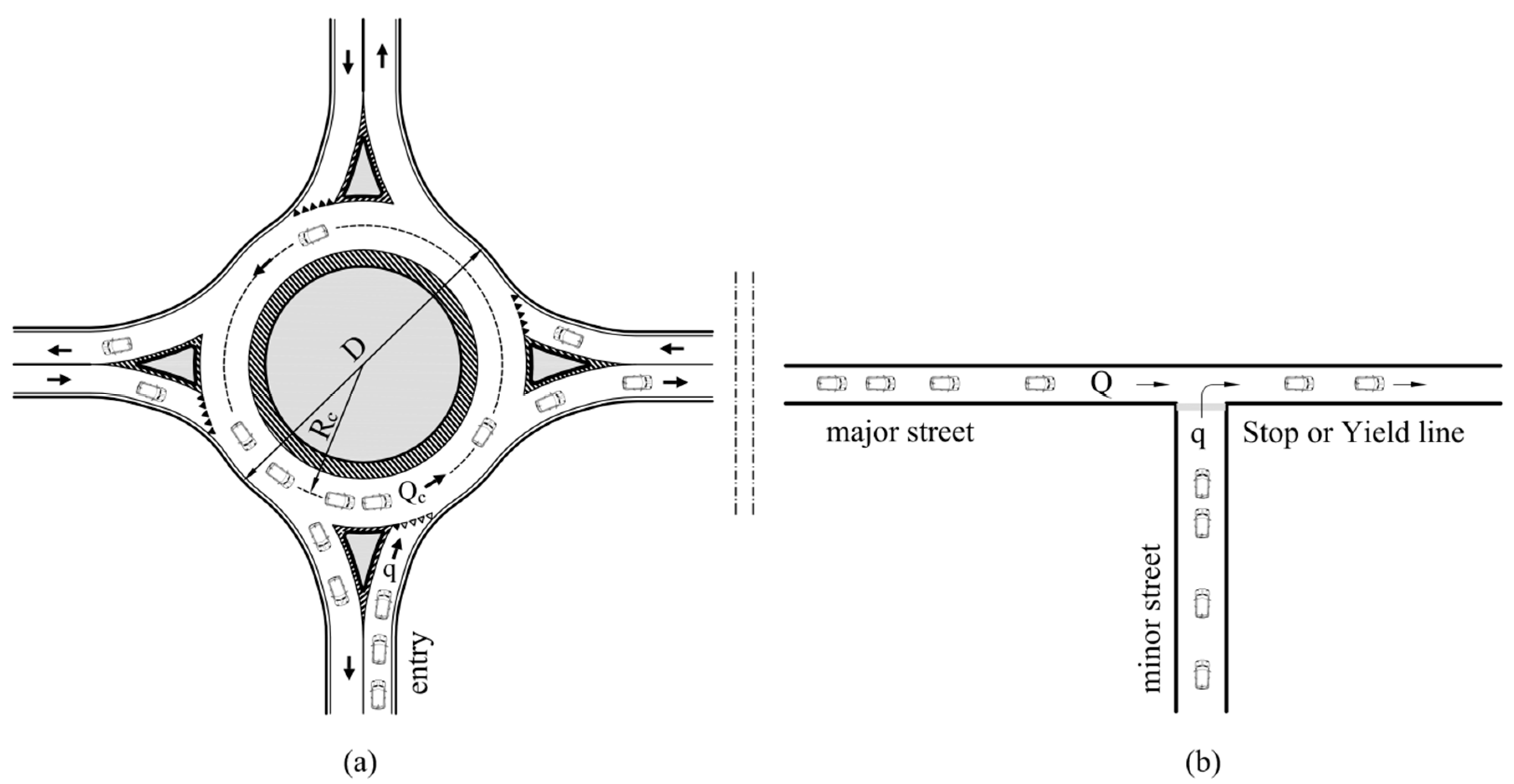
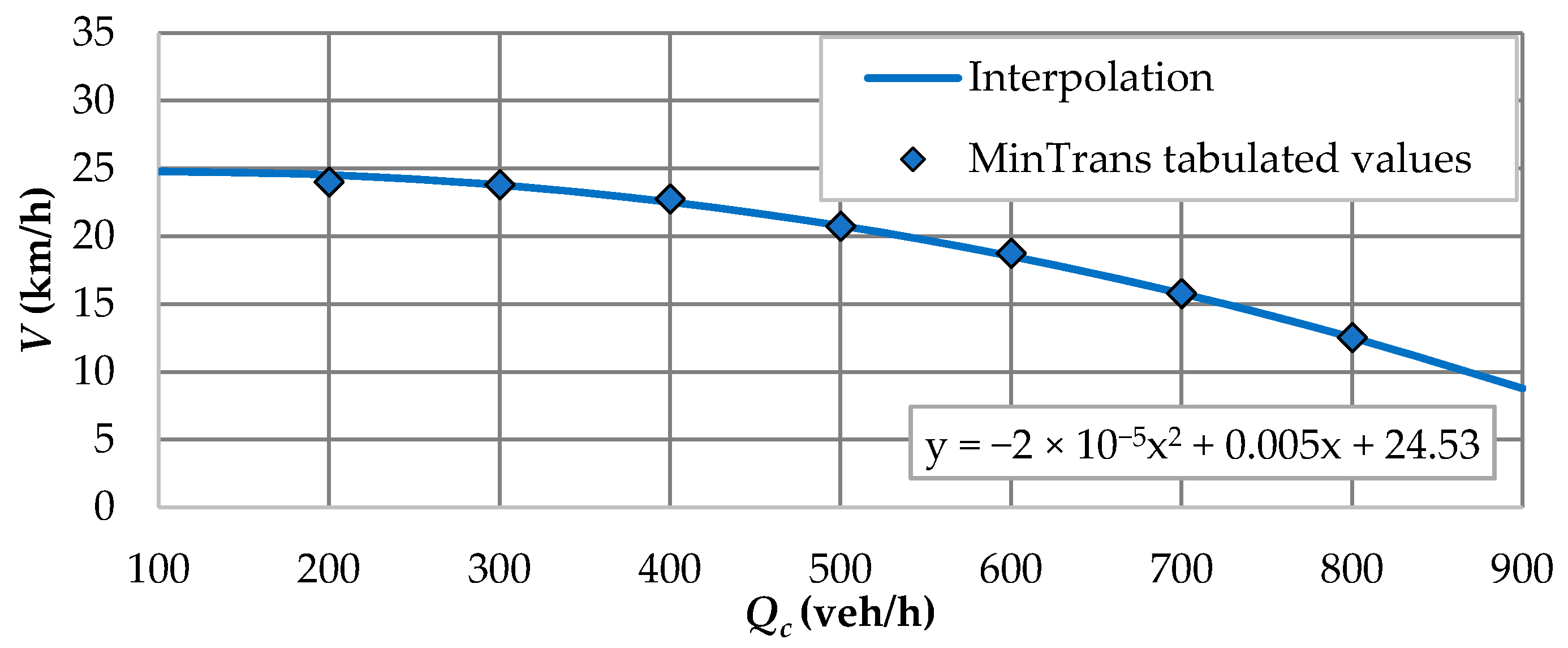
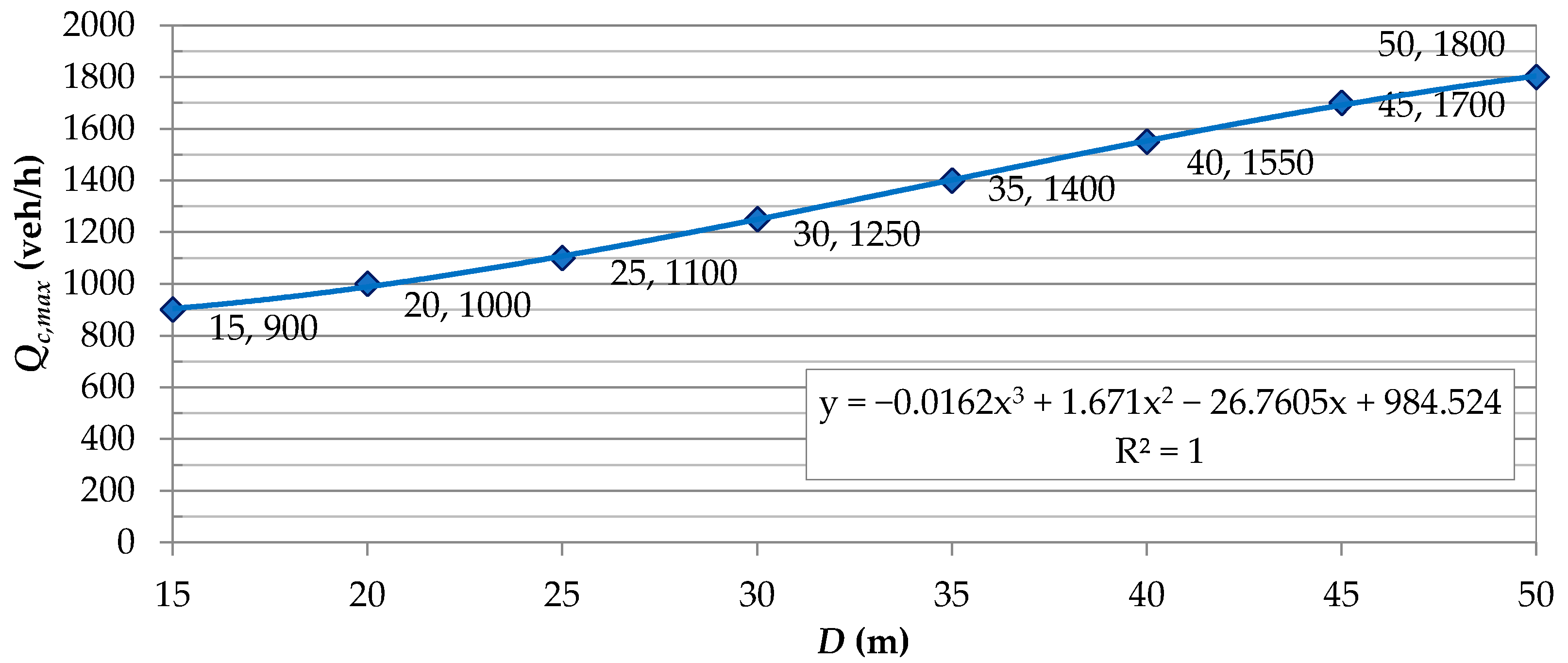
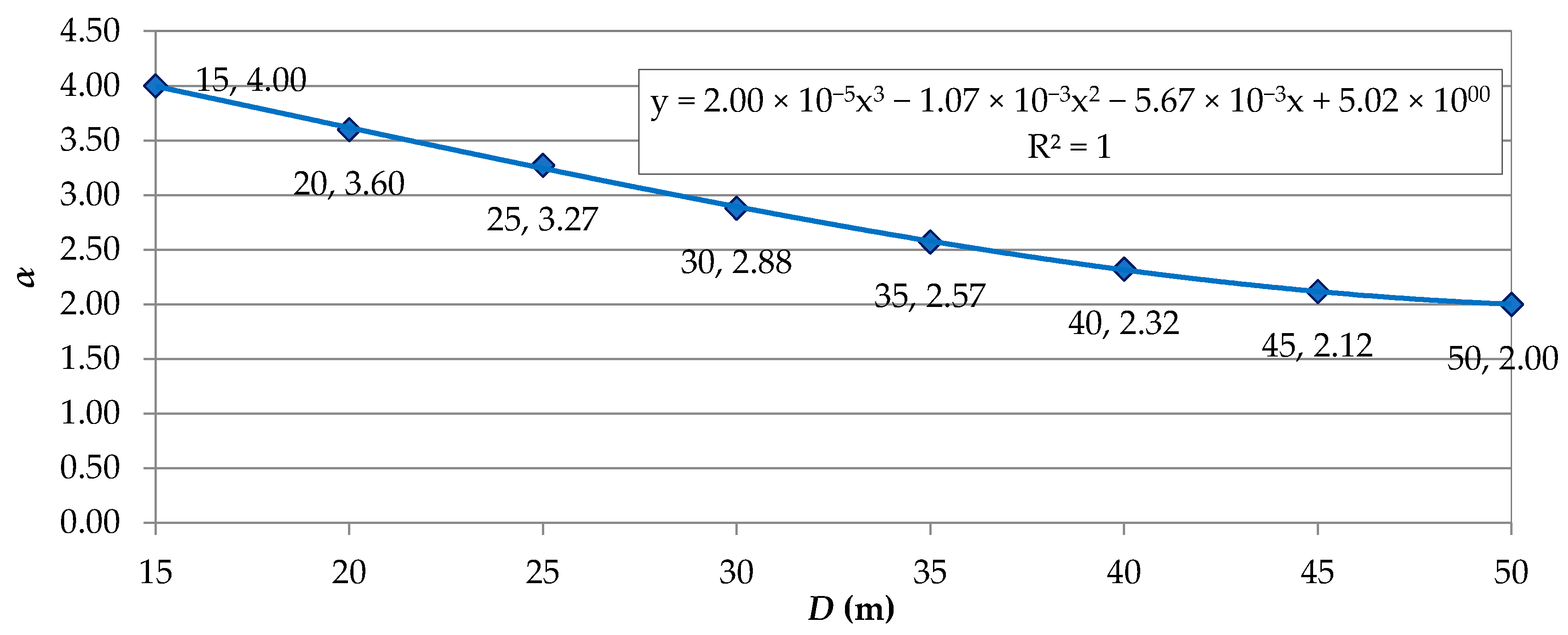


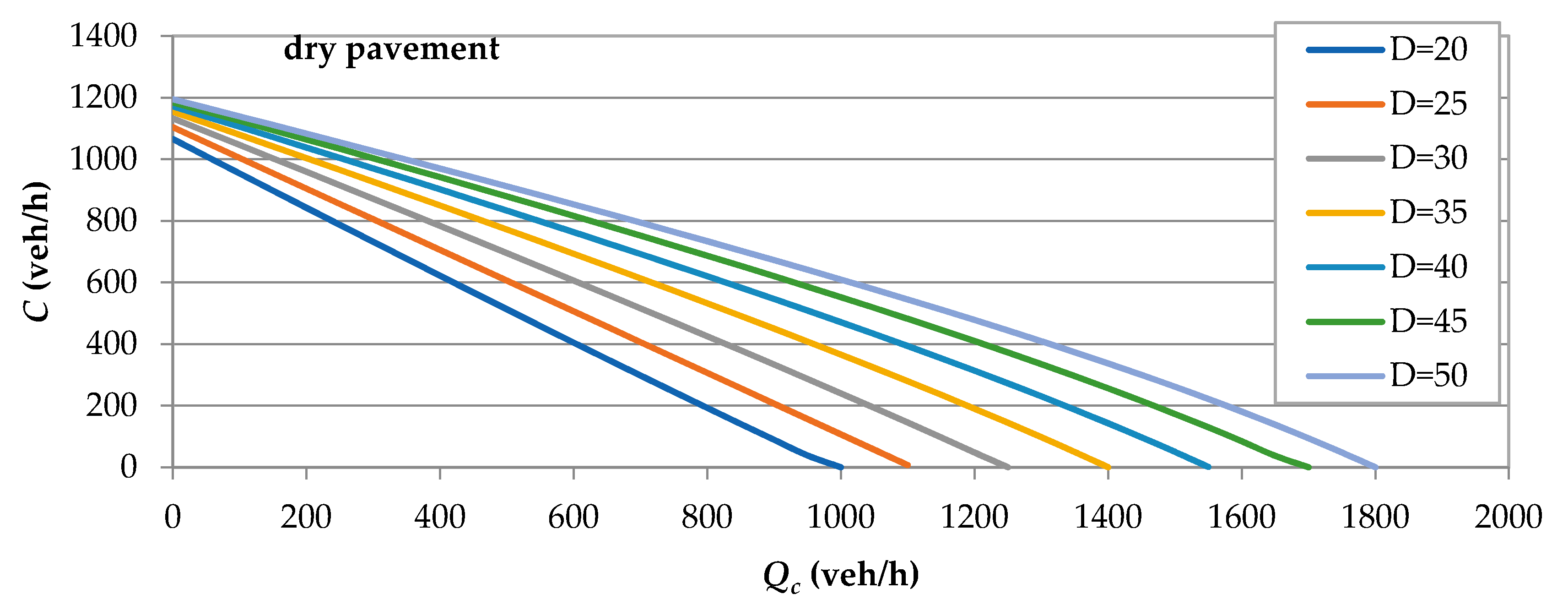
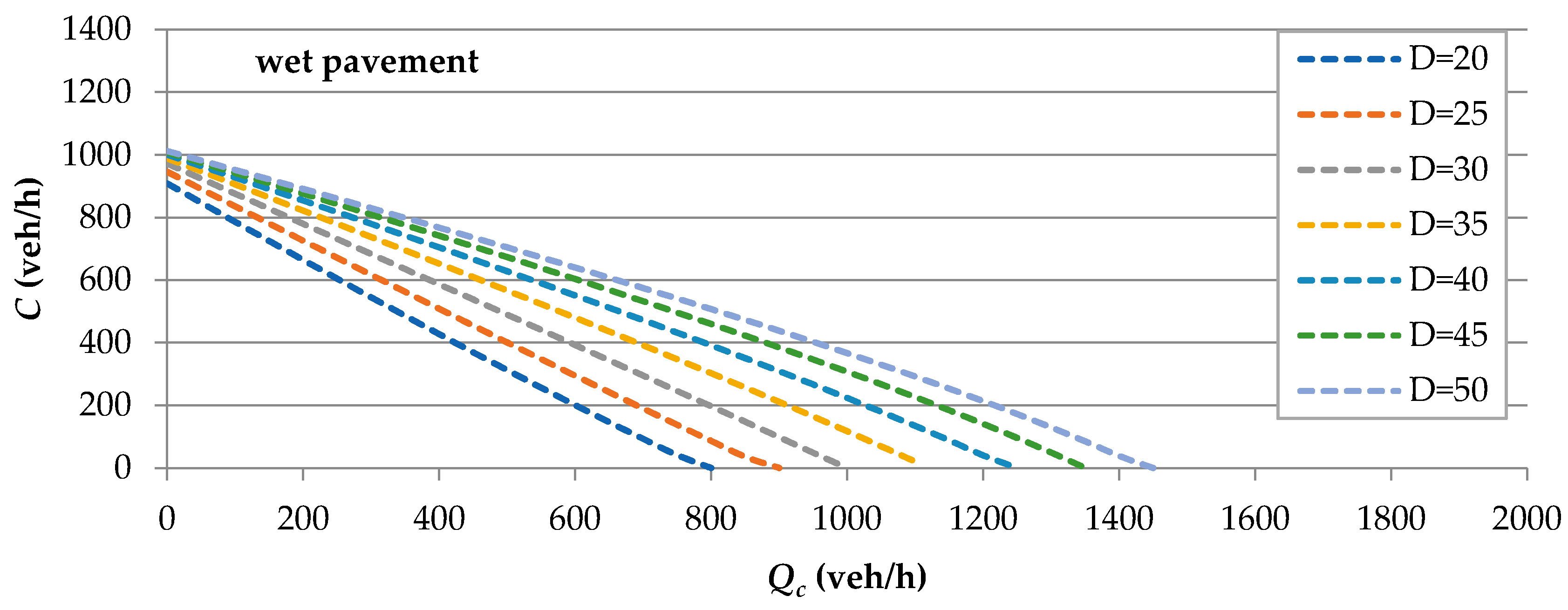
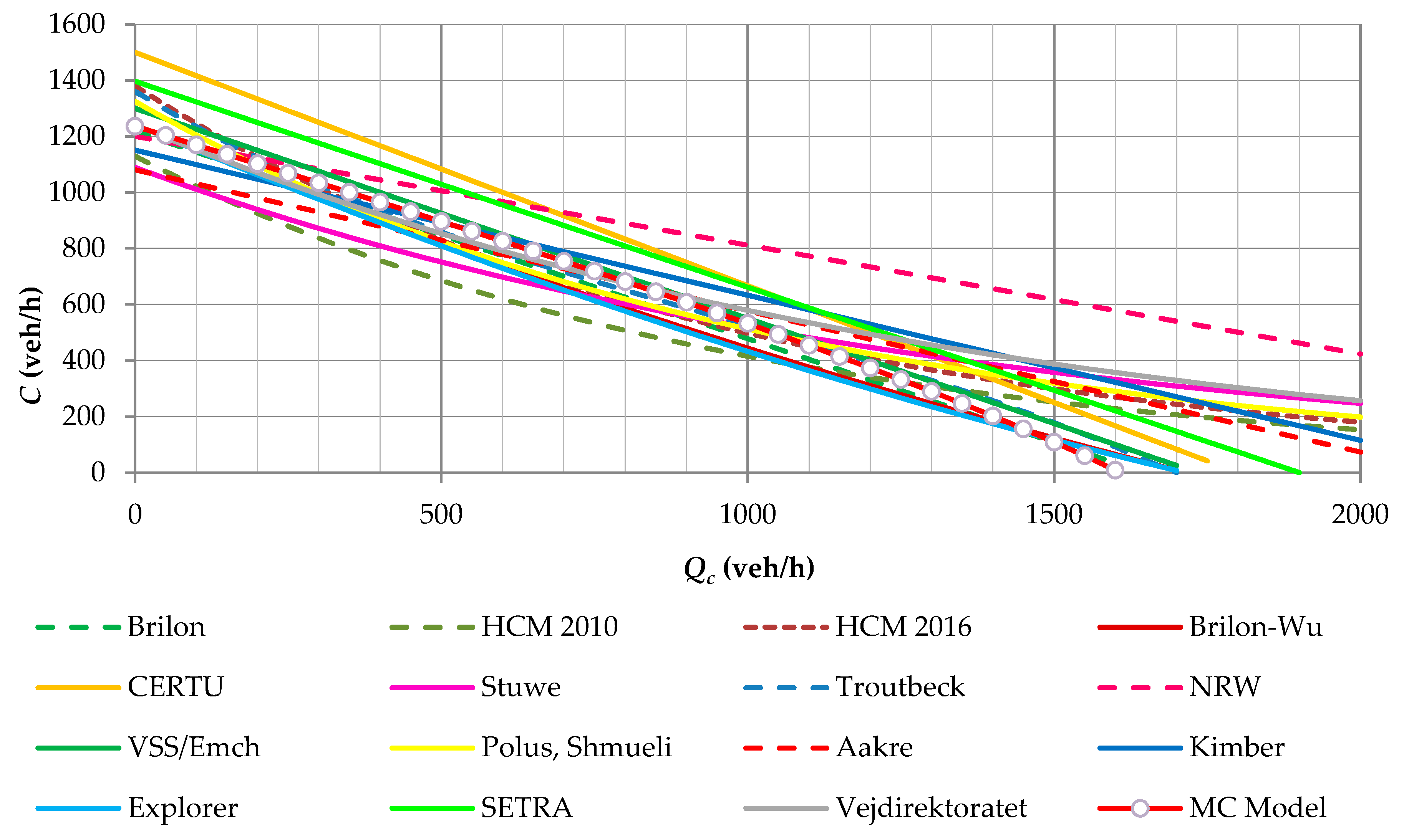


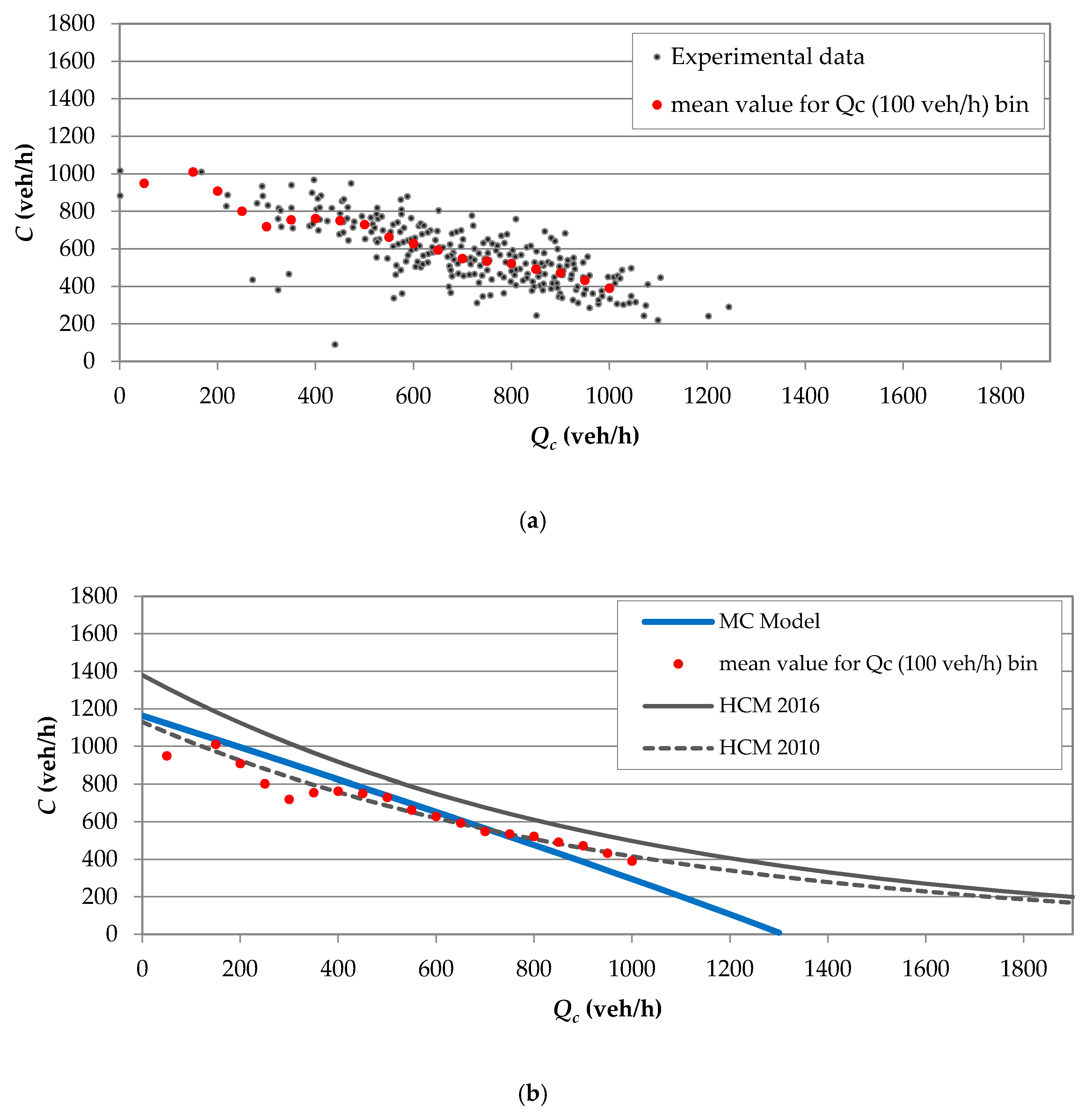
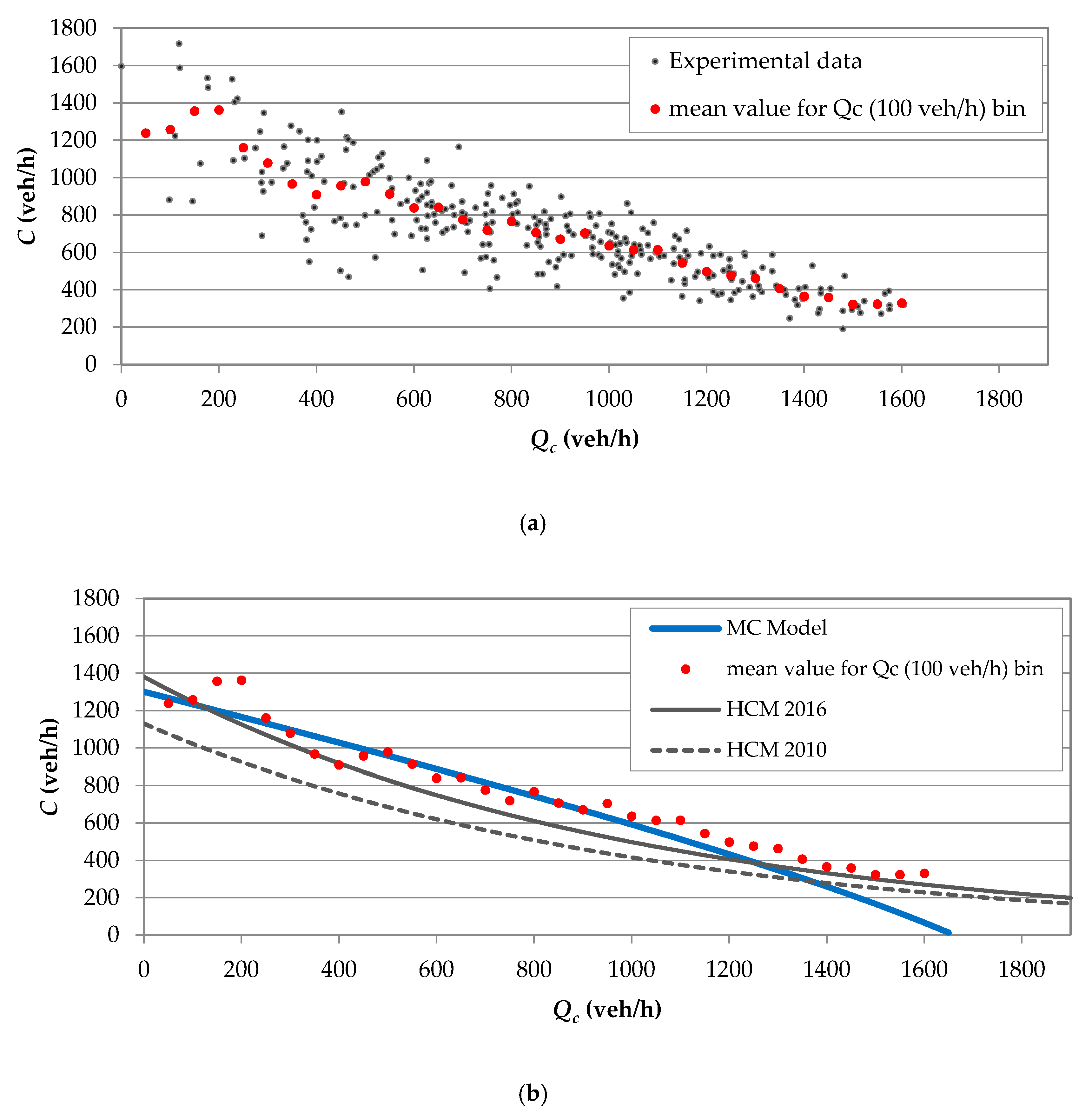
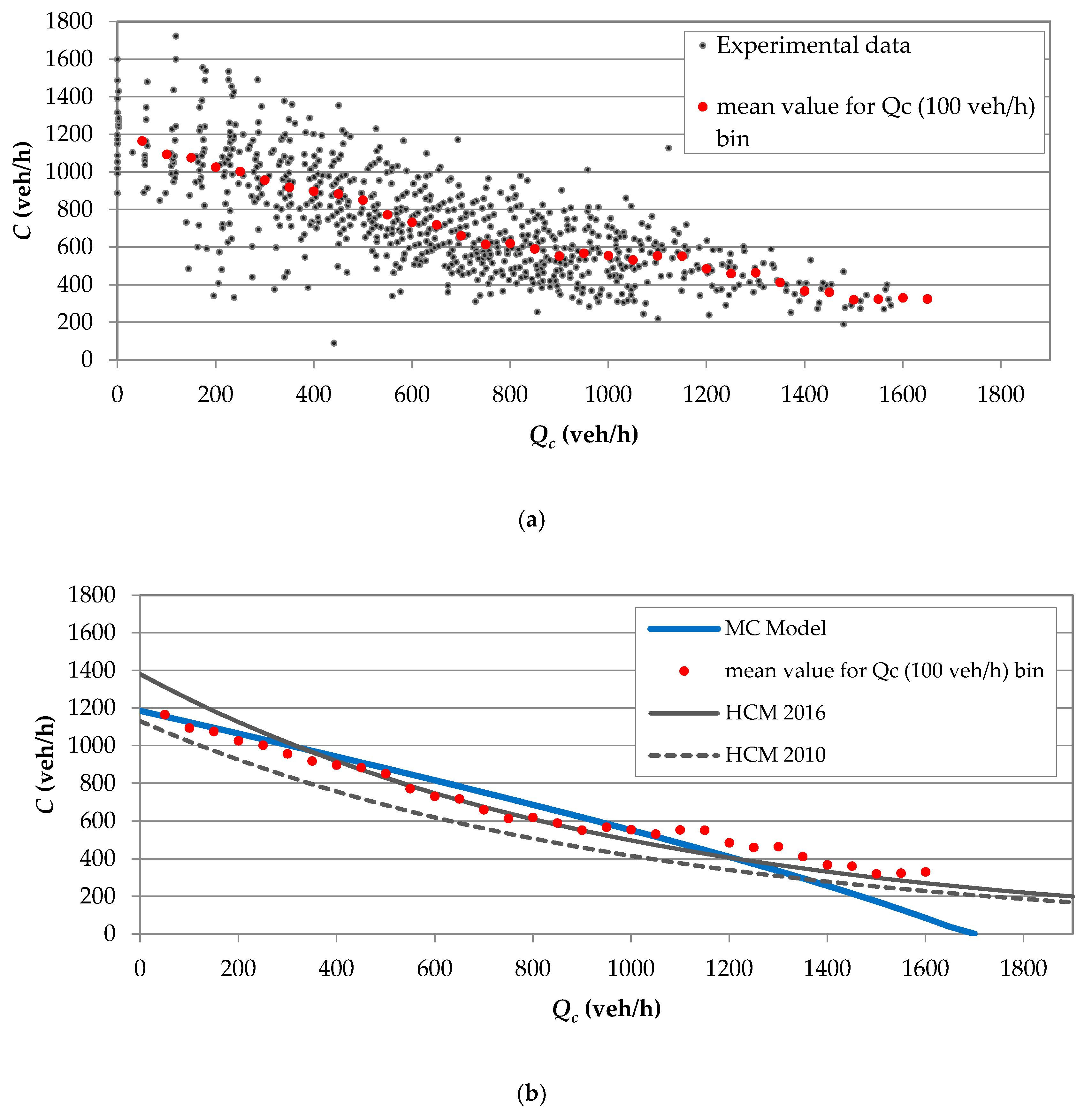
| Model | Dataset A | Dataset B | Dataset C | Dataset D |
|---|---|---|---|---|
| MC | 61 | 111 | 102 | 104 |
| HCM 2010 | 336 | 170 | 111 | 68 |
| HCM 2016 | 202 | 51 | 222 | 123 |
| Model | Dataset A | Dataset B | Dataset C | Dataset D |
|---|---|---|---|---|
| MC | 12% | 18% | 13% | 16% |
| HCM 2010 | 66% | 27% | 15% | 10% |
| HCM 2016 | 40% | 8% | 29% | 19% |
© 2020 by the authors. Licensee MDPI, Basel, Switzerland. This article is an open access article distributed under the terms and conditions of the Creative Commons Attribution (CC BY) license (http://creativecommons.org/licenses/by/4.0/).
Share and Cite
Pompigna, A.; Guerrieri, M.; Mauro, R. New Extensions and Applications of the Modified Chumanov Model for Calculating Entry Capacity of Single-Lane Roundabouts. Sustainability 2020, 12, 6122. https://doi.org/10.3390/su12156122
Pompigna A, Guerrieri M, Mauro R. New Extensions and Applications of the Modified Chumanov Model for Calculating Entry Capacity of Single-Lane Roundabouts. Sustainability. 2020; 12(15):6122. https://doi.org/10.3390/su12156122
Chicago/Turabian StylePompigna, Andrea, Marco Guerrieri, and Raffaele Mauro. 2020. "New Extensions and Applications of the Modified Chumanov Model for Calculating Entry Capacity of Single-Lane Roundabouts" Sustainability 12, no. 15: 6122. https://doi.org/10.3390/su12156122
APA StylePompigna, A., Guerrieri, M., & Mauro, R. (2020). New Extensions and Applications of the Modified Chumanov Model for Calculating Entry Capacity of Single-Lane Roundabouts. Sustainability, 12(15), 6122. https://doi.org/10.3390/su12156122







